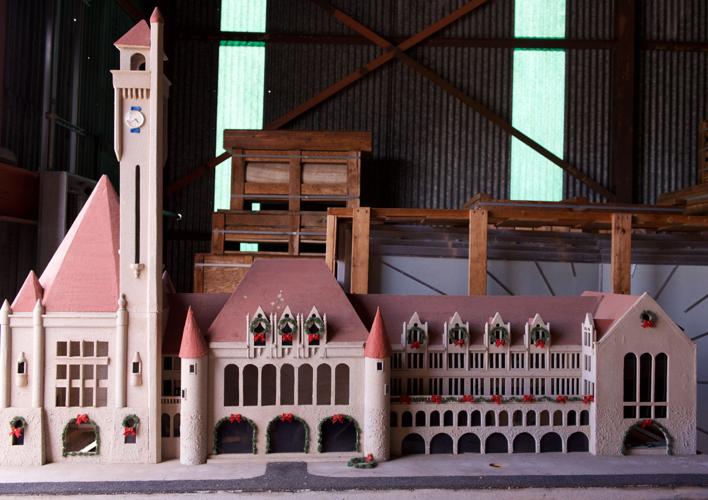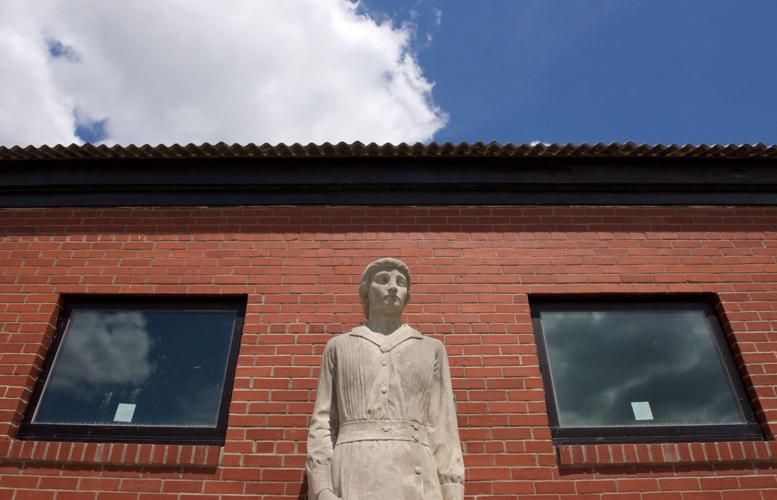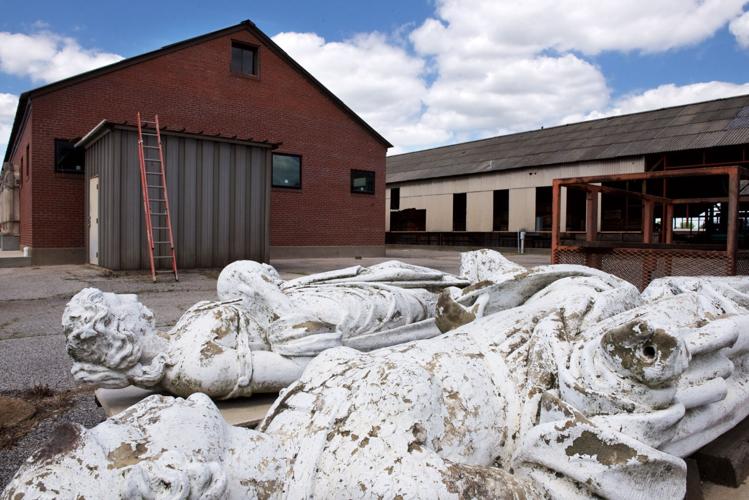Any ��ѿ��ýan of lengthy tenure can name at least one old glorious building they miss, one whose existence has been demolished to dust.
Either that or it’s in Larry Giles’ backyard in Sauget.
Also known as the , Giles’ backyard is a 15-acre lot of gravel and sporadic grass, sprinkled with 13 sheet-metal sheds, each about 120 feet long and in total holding 600 tractor-trailer loads of artifacts.
And when Giles tells you he has “a couple of hundred thousand or so artifacts,” he’s not talking about desk statues and knick-knacks.
He’s talking bigger. Way bigger.
Like the 70-foot Wellston State Bank tower that had a revolving lighted ball/weather beacon on top that could be seen for seven miles.
People are also reading…
“It had a system for forecasting weather in neon colors, and you could get a card inside the bank that let you decode the system,” Giles said.
Or maybe you prefer the three 15-foot statues of stern, dedicated women who peered out for decades from the old Deaconess Hospital School of Nursing until it was torn down in 2014.
Or take your pick of either the “Flora Gates,” which once guarded the main entrance to Shaw’s Garden, or the French Village Drive-In signs, which glowed at the main entrance to the long-gone Metro East movie lot.
If that’s not enough of a big-ticket item for you, then check out the entire facade of the old Ambassador Theater — though it will look more like the 360 crates it takes to hold the terra cotta face of the old showplace.
Some other theater is to your liking? Then go with either that old Rialto on Sixth Street or the Granada on Gravois Avenue. They take up fewer crates.
Or take some time to visit “Minerva” and “Urania,” two statues from the famed Equitable Building that stood at Sixth and Locust streets that fell in 1956.
Built in 1872 and designed by famed ��ѿ��ý architect George I. Barnett, the two were among numerous statues that stood along the building’s entire roofline. But when the building was renovated to add five floors in 1886, the statues were removed and lost to time — until Giles discovered two of them on the grounds of a stately home near Ironton, Mo.
After preservationists lose a fight to save a historic building, Giles is the guy who keeps a keen interest in saving what’s left.
He uses cranes, hoists and any other tool he needs to salvage at least some piece of vanishing history. Some of the material he sells to construction companies and developers who specialize in historic preservation.
And the collection is not just about ��ѿ��ý.
“This is by far the biggest collection of its kind in the U.S.,” he stated. “We have more artifacts of old New York City buildings than New York City does.”
Giles has turned the old Sterling Steel Casting Co. foundry into this boneyard of bricks, steel, iron and every other type of historical building material you can name.
He is proud that students and scholars use the museum’s reference materials for their studies and hopes to see the place eventually open as a public museum, and ultimately house a building-arts college.
Giles’ knowledge of building materials is encyclopedic, and his recall is amazing, though he believes his mental file is not as agile as it once was.
So when you ask him where he got the ornate etched window, it takes him three or four seconds to say “a Maplewood Masonic Lodge, built around 1900.” And then it takes him a couple of more seconds to look across the yard and note that “the cornerstone to the lodge is over there somewhere.”
Giles didn’t start out to be a building protector when he was growing up in the Central West End and attending Stix Elementary School.
After his family moved to Los Angeles for his high school years, they returned home in time for Giles to go to Vietnam with the Marine Corps and see action at the Battle of Hue — “and some others, but Hue’s the one everyone remembers.”
When he came back home in 1970, he and a few other urban pioneers fell in love with Soulard buildings and formed the Soulard Restoration Group.
“We even set up a tool co-op so all those early urban pioneers could work on saving the buildings there. And we cleaned out and fixed up and saved at least 100 homes,” he said.
Clearly, the museum is a perfect place for Bill Hart and the Missouri Alliance for Historic Preservation to hold their annual “Places in Peril” party.
On Friday, starting at 5:30 p.m., Hart’s group will throw an “unhappy hour,” at which they will announce 15 structures in the state that are in danger of being demolished. (. For information, call 1-660-882-5946 or )
Since it’s a surprise, Hart would only say that one ��ѿ��ý city site will be added to the “PIP” list.
Sadly, one will be removed.
“We’re taking off the Clemens House, because it’s all but gone now,” Hart said, referring to the home of Mark Twain’s uncle in ��ѿ��ý that was .
Offering some consolation, Giles pointed to a dozen or so cast iron pillars used to hold up the home’s portico, lying in a row in his yard. “We saved those,” he said.
Hart first met Giles in the “late 1970s, early ’80s,” when both were fighting the Gateway Mall plan that eventually demolished several cherished structures, such as the Buder and Title Guaranty buildings.
A Perryville, Mo., native and now a Benton Park resident, Hart came to ��ѿ��ý in the mid-1970s and fell in love with Lafayette Square. “For a kid from Perryville, it was like I’d died and gone to Europe,” he said.
So Hart fights to save old buildings, and Giles scrambles to preserve what he can when the fight fails. Simple enough.
But in as few words as possible, why do they do what they do?
“Old stuff matters,” Hart said. “It’s our history.”
For Giles, it was more personal. “I guess I don’t know any better.”





















